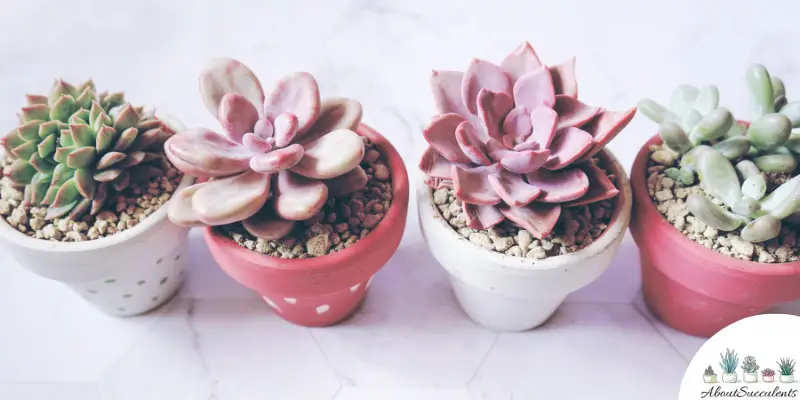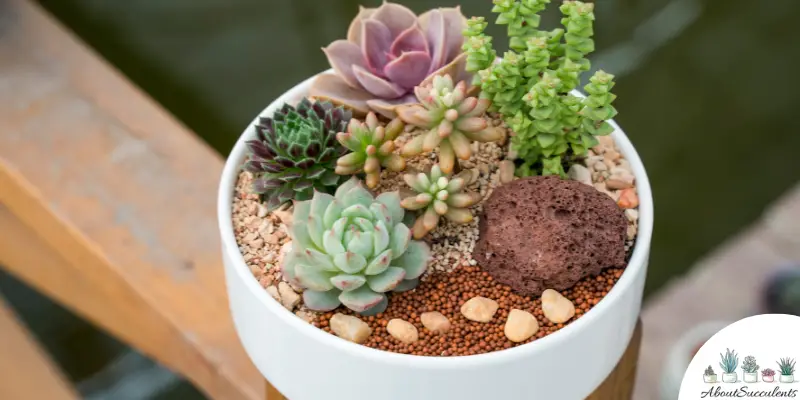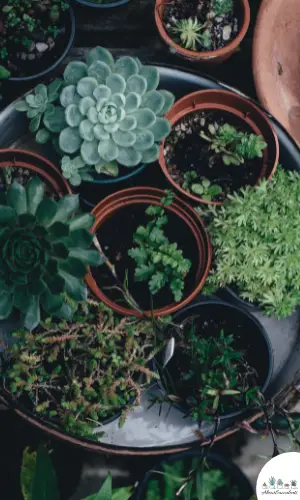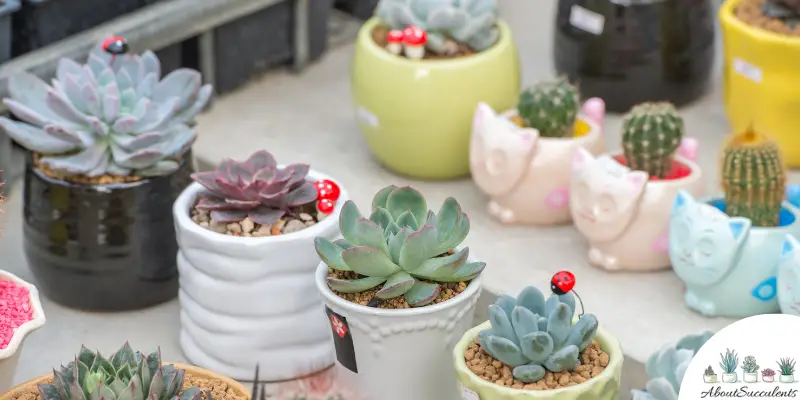
Hobbyists and horticulturists love succulents because they make wonderful indoor plants. Put them on a mantle in your living room and they make an interesting conversation piece.
In an office, the Echeveria Perl Von Nurnberg on your shelf or office table will immediately draw attention with its captivatingly beautiful rosette.
Restaurants, hotels, and spas grow their succulents indoors because they add elements of elegance and sophistication. Why else would a prestigious bank or hotel have a succulent plant inside their restrooms?
In addition to their aesthetic appeal, succulents are easy to grow and care for even when they are located indoors.
What Are The Best Succulents To Grow Indoors?
As cute and beautiful as the succulent that you came across might be, it might not be suitable for an indoor environment.
In general, succulent plants that have bright-colored leaves are not ideal choices for indoor plants. To achieve their bright colors, these types of succulent plants need full exposure to sunlight.
Succulents that have green colored leaves and those that store a lot of water such as the aforementioned echeveria make the best choices for indoor plants.
If you’re thinking of growing succulents indoors, here’s a list of 10 varieties that you can consider:
- Christmas Cactus
- Jade Plant
- Panda Plant
- Snake Plant
- Zebra Haworthia
- Burro’s Tail
- Hens and Chicks
- Aloe Vera
- Ponytail Palm
- African Milk Tree
These types of succulents are perfect for the indoors because they don’t need much sunlight, store plenty of water, and look amazing!
Now, if you’re thinking that indoor succulents do not need as much TLC as outdoor succulents, think again.
In fact, because the succulent is growing outside its natural habitat, you may have to put in more time and effort to help the plant thrive in the “Great Indoors”.
How To Choose The Best Pot And Soil For Your Indoor Succulent

After you’ve chosen the succulent that you want to grow indoors, the next step is to find the best pot and soil for the plant to live in.
If you’re buying the succulent from a local nursery or garden store, the plant will most likely be kept in a cheap, plastic container. Take a look underneath the pot. It probably doesn’t have a drain hole to remove excess water.
As we will discuss later, overwatering is the number one cause of death for succulents. It’s very important to get the soil completely dry as soon as possible after it has been given a thorough watering.
The best type of pot you can buy for your succulent is one that supports proper evaporation of moisture from the soil. A pot made of terra cotta or unglazed clay is the best choice for your succulent plant.
Terra Cotta and unglazed clay will allow moisture to escape from the sides of the pot faster than any other material. Make sure the pot has a drainage hole with a mesh covering to prevent soil from coming out.
Your choice of the pot must also be big enough to allow the roots of the succulent to grow properly and for air to circulate evenly throughout the soil.
Did someone give you a sophisticated glass bowl last Christmas? Use it for something else. Don’t use the glass bowl to plant your succulent in.
Glass has very poor qualities for encouraging evaporation. And it’s very likely that the glass bowl does not have a drain hole.
Now, let’s move on to the best type of soil that you can plant your succulent in.
Again, your priority should be to find a type of soil that dries out right away. It must have excellent drainage properties, improve moisture content, and have ingredients that kill pathogens.
You can buy commercially-available products in the market such as Cactus soil that has other materials like pumice and perlite to improve drainage and sterilized to remove pathogens.
Another option is to make your own by using the following materials:
- Garden soil – 3 cups
- Sand – 2 cups
- Perlite and/or Pumice – 1.5 cups
First, sterilize the garden soil by baking it in an oven at 200 degrees Fahrenheit (93 degrees Celsius) for 30 minutes.
Second, once the sterilized soil has cooled down, lightly moisten it with water to prevent dust from coming up the surface.
Third, mix in the other ingredients – 2 cups of sand and 1.5 cups of perlite and/or pumice – by hand. You can choose either perlite or pumice but a combination of both ingredients will give you better results.
When this is all done, it’s time to re-pot your succulent.
How To Re-Pot Succulents

To get the succulent out of the plastic pot it came with, gently remove it from the soil.
You may have to do some light digging but do what you can to make the process of removing the succulent as easy and trouble-free as possible.
Great care must be undertaken to ensure that the roots of the succulent plant are not damaged. Shake off excess soil from the succulent then allow it to dry out in a clean area.
Before putting the soil into the new Terra Cotta pot, you may want to consider adding a layer of small pebbles to further improve drainage. Only add soil up to ¾ of the way of the pot.
If the soil is completely dry by the time you re-plant the succulent, give it a thorough watering.
How Much Sunlight Does Your Indoor Succulent Need?
Even varieties of succulents that store a lot of water and are known to be highly tolerant of drought conditions need regular sunlight to produce food.
When grown indoors, a succulent will not have the benefit of getting direct sunlight unlike those that are grown in an outdoor garden.
To thrive, a succulent must receive 3 to 6 hours of sunlight every day. Thus, when looking for an indoor location for your succulent plant, the ideal place would be one that is near a window that gets a good daily dose of morning sunlight.
The recommended locations are windows found on the south, east, and west areas of your house.
Your succulent can suffer from a condition known as etiolation if it does not get enough sunlight.
When a succulent is afflicted with etiolation, its leaves will stretch out as if looking for sunlight. Your succulent will appear brittle, thin, stretched out, and very weak. Its once-dark green leaves will exhibit a lighter, more pale color.
If getting enough indoor sunlight is not possible, your next option would be to buy a Grow Light and place your succulent under it for up to 6 hours every day.
How To Properly Water Your Succulent Indoors

Succulent plants store water in their leaves and stems. The ability to store large amounts of water makes many varieties of succulent plants resistant to drought and dry conditions.
However, like other plants, succulents need water to extract nutrients from the soil. You should still pay attention to the plant’s watering schedule because too much water can kill your beloved succulent.
As we mentioned earlier, overwatering is the number one cause of death for succulents. Its roots cannot be submerged in a moist environment for a long period of time. Otherwise, its cells would get damaged and the roots would start to rot.
Once root rotting starts, it can spread quickly throughout the plant. You will know if the roots are rotting if you notice the leaves take on a brownish or blackish appearance.
So how do you water indoor succulents?
The same way as you would outdoor succulents – wait for the soil to get completely dry before giving it water.
There are 3 ways to assess the moisture level of the soil.
First, touch the topsoil with your hand. If it feels dry to the touch, it’s time to water the plant.
Second, use the stick method. Insert one end of the stick one-inch into the soil. If the end of the stick feels dry after you pull it out of the soil, get ready to give the plant some water.
Third, use a hygrometer. A succulent does not directly use the water in the soil to extract its nutrients. Instead, the plant uses the moisture in the air.
A hygrometer is a device that measures the level of moisture in the air. If the reading is low, be prepared to give the soil a good drenching.
Always water the succulent at the bottom and never from the top. If you get the leaves wet, it will take longer for the soil to dry out.
How much water should you give a succulent?
If you see the drain tray underneath the pot getting filled up, the soil has received enough water.
Usually, a succulent needs to be watered every 7 to 10 days. However, in colder seasons the soil will take longer to dry out and the plant will require less water.
How To Keep Pests Out Of Your Indoor Succulent

Indoor succulents are also susceptible to pest infestation as that that are grown outdoors. After all, you have no control over what kinds of creatures invade your home.
Likewise, the succulent may be harboring pests when you bought it from the nursery.
The most troublesome pests for your indoor succulent are mealybugs, aphids, fungus gnats, and ants.
These pests are harmful to your plant because they drain it of nutritious sap then excrete a bacteria-filled substance that can infect your succulent.
You can keep pests away from your indoor succulent by following our tips:
- Remove dead leaves that have accumulated near the plant. Mealybugs are attracted to dead leaves.
- Spray the succulent with neem oil or a mild insecticide.
- You can keep fungus gnats away by ensuring that the soil drains properly.
- You can remove mealybugs by hand or with a pair of tweezers.
Mealybugs leave a white, cotton-like substance on the plant. You can get these substances out by rubbing the leaf with cotton that has been dipped in denatured alcohol.
Conclusion
It will take a bit more time and effort to successfully grow succulents indoors but your patience will be richly rewarded by having beautiful, charming plants that adorn your home.
Follow our advice carefully and be ready to grow your collection of indoor succulents in no time at all!
Last Updated on June 27, 2022 by Sofia Lara